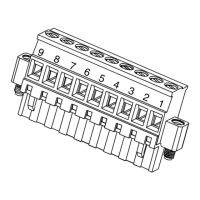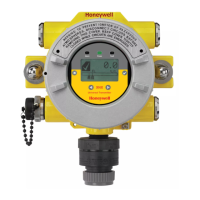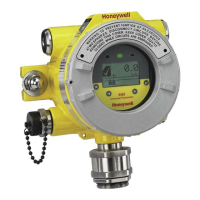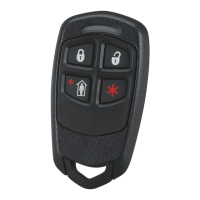XNX Universal Transmitter
HART Protocol
180
connected via HART communication. A copy of the le is included
on the Documentation CD or can be downloaded from the HART(R)
Foundation website. This DD le can be installed on HART-enabled
Emerson eld communicators using the Emerson Easy Upgrade
Utility. The DD les are compatible with the software integral to the
transmitter. Older transmitters using earlier versions of software
require previous versions of the DD les. Contact your local
Honeywell representative with any questions regarding software
compatibility.
During manufacturing, Honeywell congures the 8-digit HART
tag to the XNX serial number. This can be used to conrm correct
wiring from the transmitter to the control system. If desired, the
HART tag can be modied. The xed XNX serial number can also
be read over HART.
For convenience, the transmitter presents the HART signal on
two interfaces. The 1200 Hz AC signal is capacitively coupled to
the main mA current analog output. This may be monitored at the
control system or at any point along the 20 mA loop. Additionally,
the optional local HART interface (Honeywell part number XNX-
HIF) permits temporary connection of a HART terminal to the
transmitter. This local HART port is transformer-coupled to the
main mA current output. This port is intrinsically safe and polarity
insensitive. See the Local HART Interface section for more
information.
The internal HART modem functions as a high-impedance current
source. Thus transferring the HART signal requires a certain
minimum loop resistance between the slave and a low-impedance
power supply.
Normally, this resistance is supplied by the control system
and need not be explicitly added. However, special treatment
is needed when the mA current output is not used and the
local HART interface is needed. An installer might choose to
communicate using relays, Modbus, or FOUNDATION Fieldbus
instead. In that case, the supplied 510 ohm resistor must be tted
to create an “articial” mA current loop. Connect the resistor
between TB-1 terminal 1-3 and terminal 1-6. Additionally, place S1
and S2 in source conguration. This is shown schematically in the
HART “source” wiring illustration.
The digital HART interface provides all of the capabilities of the
local user interface. The transmitter has been designed to use the
portable Emerson eld communicator with DevCom2000 software
for Microsoft Windows
®
and Emerson AMS Intelligent Device
Manager. Using HART, a service person can display information,
test, calibrate, and congure. An outline of the HART menus is
provided in the Handheld Online Menus section.
ATEX Conditions for Safe Use of Intrinsically Safe HART
Handheld Devices
For installations in which both the Ci and li of the intrinsically
safe apparatus exceeds 1% of the Co and lo parameters of the
associated apparatus (excluding the cable), 50% of Co and lo
parameters are applicable and shall not be exceeded, i.e., the Ci
of the device plus the C of the cable must be less than or equal to
50% of the Co of the associated apparatus, and the li of the device
plus the l of the cable must be less than or equal to 50% of the lo of
the associated apparatus.
